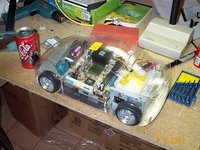Following are the highlights:
Changes in I-T slab. Threshold of exemption for all Income Tax assesses raised from from Rs 1,10,000 to Rs 1,50,000.
Every income tax assessees to get relief of minimum of Rs 4,000.
No change in rate of surcharge.
New tax slabs will be: 10 per cent for Rs 150,000 to Rs 300,000, 20 per cent for Rs 300,000 to Rs 500,000 and 30 per cent above Rs 500,000.
For women, the income tax limit goes up from Rs 1.45 lakh to Rs 1.80 lakh. In case of senior women citizens, it increases from Rs 1.95 lakh to Rs 2.25 lakh.
Fresh facilities, encouragement to sports and guest houses exempted from Fringe Benefit Tax.
Five year tax holiday for setting up hospitals in tier II and tier III regions for providing healthcare in rural areas from April 1, 2008.
Five year tax holiday for promoting cultural tourism.
Short-term capital gains increases to 15 per cent.
Commodities Transaction Tax to be introduced on the lines of Securities Transaction Tax.
Banking cash transaction tax withdrawn from April one, 2009.
Direct tax proposals to be revenue neutral. Indirect tax proposals to result in loss of Rs 5,000 crore.
Rs 500 crore for corpus fund to subsidise all women Self Help Groups for LIC cover for permanent disability.
Agricultural loans given by scheduled commercial banks, regional rural banks and cooperative credit institutions up to March 31, 2007 and due for December 31 that year will be covered under the waiver scheme to address the problem of indebtedness.
No change in corporate income tax.
To protect tigers, Rs 50 crore for National Tiger Conservation Programme. Bulk of it to be used to raise Tiger Protection Force.
Plan expenditure fixed at Rs 2,43,000 crore and non plan expenditure at 5,74,000 crore.
Fiscal deficit pegged at 3.1 per cent and revenue deficit at 1.4 per cent.
Tax to GDP ratio increased from 9.2 per cent in 2004-05 to 12.5 per cent 2007-08.
No change in peak rate of customs duty for non
Customs duty on specified life saving drugs reduced from ten per cent to five per cent.
Special Countervailing Duty on power imports.
Customs duty on specified sports goods machinery down from 7.5 per cent to five per cent.
Duty withdrawn on naptha for production of polymers.
Duty on crude and unrefined sulphur reduced from five to 2 per cent to help raise domestic fertiliser production.
General Centvat on all goods to be reduced from 16 per cent to 14 per cent. Excise duty reduced from 16 per cent to eight per cent on all pharmaceutical goods manufacture.
Excise duty on small cars reduced to 12 per cent from 16 per cent and hybrid cars to 14 per cent.
Excise duty reduced from 16 to 8 per cent on water purification items.
Duty on non filter cigarettes to be raised.
Asset management service under mutual funds, services by stock exchanges to be brought under Services Tax net.
Threshold for small service providers raised from Rs eight lakh to Rs 10 lakh.
Allocation for defence to be increased by 10 per cent from Rs 96,000 crore to Rs 1,05,600 crore.
75 lakh people to be covered by health insurance scheme.
Allocation for Textile Upgradation Fund to be more than doubled.
Micro, small and medium enterprises to continue to get special attention.
Risk Capital Fund to be set up in SIDBI.
PAN requirement to be extended to all transactions in capital market subject to a threshold.
Rs 750 crore for upgradation of 300 ITIs in 25 districts.
Rs 32,676 crore as subsidy to Public Distribution System.
PDS through smart cards in Haryana and Chandigarh on pilot basis.
Three schemes to be introduced for providing social security to unorganised sector workers.
Sixth central pay commission to submit report by March 31, 2008.
Rs 624 crore allocated for Commonwealth Games
Farmers' debt to be waived
Complete waiver of loans for marginal farmers owning land up to one hectare and small farmers owning land up to 1 and 2 hectares.
Agricultural loans given by scheduled commericial banks, regional rural banks and cooperative credit institutions up to March 31, 2007 and due for December 31 that year will be covered under the waiver scheme to address the problem of indebtedness.
One time settlement of loans for other farmers.
Agriculture loans restructured and rescheduled by banks from 2004-06 and other loans normally rescheduled under RBI guidelines will also be eligible under the waiver scheme.
Implementation of debt waiver and debt relief will be completed by June 30 this year.
Loan waiver scheme to involve loans liability of Rs 60,000 crore and to benefit four crore farmers.
By loan waiver scheme, the country is discharging a deep debt and sense of gratitude to farmers, says Chidambaram.
The corpus of rural infrastructure development fund to be raised to Rs 14,000 crore.
More reforms needed in coal and electricity sectors to ensure double digit growth in manufacturing sector.
Rs 800 crore for accelerated power reforms programme.
National Fund for Transmission and Distribution Reforms to be launched.
The loan waiver scheme will benefit three crore small and medium farmers and cover loans totalling Rs 50,000 crore.
One crore other farmers will benefit to the tune of Rs 10,000 crore in the waiver.
Foreign investment of 3.5 to 8 billion dollars expected for exploration and development of new oil blocks.
Rs 7,200 crore to be allocated to the Ministry of Women and Child Development, marking an increase of 24 per cent.
Rs 500 crore for corpus fund to subsidise all women Self Helf Groups for LIC cover for permanent disability.
A target of Rs 2.80 lakh crore for agriculture credit set for the coming year.
Rs 20,000 crore for irrigation projects under AIPB, showing an increase of Rs 9,000 crore over last year.
National Horticulture Mission to be given Rs 1,100 crore in 2008-09 with special focus on coconut cultivation.
Rs 75 crore to be given to Agriculture Ministry for providing mobile soil testing laboratories in 250 districts.
Rs 644 crore for National Agriculture Insurance Scheme, which will be continued pending evolving an alternative crop insurance scheme.
National Plant Protection Training Institute at Hyderabad to be made autonomous body and Rs.29 crore will be allocated to it.
A scheme of debt waiver and relief for small and marginal farmers announced.
NREGA scheme to be rolled out in all the 596 rural districts in the country in 2008-09.
Jawaharlal Nehru Urban Renewal Mission to get Rs 6,865 crore this year against Rs 5,482 crore past year.
Allocation for Rajiv Gandhi Drinking Water Mission to be increased to Rs 7,300 crore. Rs 200 crore for potable water in schools.
Rs 300 crore to be set aside for desalination plant in Chennai for drinking water.
Rs 500 crore for identifying urgent needs of development programmes of border areas like Arunachal Pradesh.
SC, ST and minority students to continue to get special attention.
Allocation for several schemes in North East raised from Rs 14,365 crore to Rs 16,400 crore.
Rs 75 crore sanctioned for Rajiv Gandhi National Fellowship Programme for SC/ST students pursuing M.Phil.
Rs 230 crore will be extended as additional equity to developmental organisations looking after the welfare of SC,
ST, socially and economically backward classes and minorities.
Allocation for Minority Affairs Ministry to be doubled from Rs 500 crore to Rs 1,000 crore.
Rs 540 crore for multi-sectoral development plan for minority concentration districts.
288 public sector bank branches to be opened in districts having minority community concentration.
Sarva Shiksha Abhiyan will be provided Rs 13,100 crore, Mid Day Meal scheme Rs 8,000 crore, Secondary education Scheme Rs 4,554 crore.
410 additional Kasturba Gandhi Vidyalaya to be set up in backward blocks.
Navodaya Vidyalayas to be opened in 20 districts with special focus on regions having SC/ST concentration.
Allocation of Rs 130 crore for this purpose. Rs.750 crore more to be given for merit scholarship to students up to 10th and 12th class.
Mid day Meal scheme extended to upper primary level in 3479 schools. 16 central universities to be opened in 2008-09.
Three IITs to be set up in Andhra Pradesh, Bihar and Rajasthan.
Schools of architecture and planning in Bhopal and Vijaywada. More institutes of higher education to be opened.
Rs 100 crore to be given to Information Technology Ministry to set up national knowledge centres.
Allocation for NRHM increased to Rs 12,050 crore
Rs 992 crore for national AIDS programme.
A national programme for the elderly to be started at a cost of Rs. 400 crore.
Rashtra Swasthya Beema Yojana to start from April one in Delhi and Haryana. Rs 30,000 for each family belonging to unorganised sector.
Allocation for ICDS increased to Rs 6300 crore.
Rs 85 crore sanctioned for scholarships to students pursuing science education.
Indian Institutes of Science Education and Research to be set up at Bhopal and Thiruvananthapuram.
Agriculture credit doubled in the first two years of the government to reach Rs.2.40 lakh crore by March 2008.
Eleventh Plan started on a robust growth.
Gross budgetary support to be raised to Rs 2,43,386 crore, an increase of more than Rs 38,000 crore from the current level.
Allocation for Bharat Nirman to be raised to Rs 31,280 crore.
Twenty per cent hike in education budget this year from Rs 28,674 crore to Rs 34,400 crore.
GDP growth slows down to 8.4 per cent during quarter ended December 31, 2007 as compared to 9.1 per cent a year ago.
Economy grew over eight per cent over 12 successive quarters since 2005, says Finance Minister P Chidambaram.
Growth rate of agricultre extimated at 2.6 per cent during the current year.
Services and manufacturing sectors expected to grow by 10.7 per cent and 9.4 per cent, says Chidambaram.
Keeping inflation under check is one of the cornerstones of the Government's policy.
Rice production estimiated at 94.08 million tonnes, maize 16.78 mt, soyabean 9.45 mt and cotton 23.38 million bales.
src="http://pagead2.googlesyndication.com/pagead/show_ads.js">







